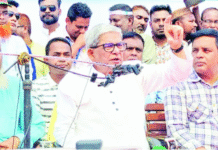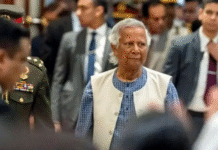Bangladesh has made a significant progress in reducing poor people by 16 million in 10 years from 2000-2010 despite the series of external shocks affecting the country in 2007 and 2008.
The country witnessed a steady and continuous decline in the number of poor people over the decade — from nearly 63 million in 2000 to 47 million in 2010.
Despite a growing population, the number of poor people declined by 26 percent in 10 years. Poverty declined by 1.7 percentage points per year.
This was revealed at a new World Bank report ‘Bangladesh Poverty Assessment: Assessing a Decade of Progress in Reducing Poverty, 2000-2010’ launched on Thursday at a city hotel.
The report said that during the period 2000-2010, poverty reduction was closely linked to the growth in labour income and changes in demographics.
The report findings said labour income, both formal and informal, was the dominant factor in higher incomes and lower poverty rates. Fertility rates have been steadily dropping over the last several decades which have resulted in lower dependency ratios and more income per-capita.
“The second half of the 2000s saw an escalation of real rural wages but the growth of urban real wages was lackluster,” it said.
Finance Minister AMA Muhith spoke on the occasion as the chief guest while Food Minister Dr M Abdur Razzaque as special guest. General Economics Division (GED) member of the Planning Commission Dr Shamsul Alam and executive chairman of the Power and Participation Research Centre Dr Hossain Zillur Rahman spoke as discussants.
World Bank Country Director Johannes Zutt made both the welcome address and concluding remarks while World Bank senior economists and co-authors of the report Dr Dean Jolliffe and Dr Iffath Sharif made a power-point presentation on the report.
Food Minister Dr M Abdur Razzaque said the country is very much on track of attaining almost all the MDG goals and the government has been staging a revolution on eradication of poverty as it declined by 1.7 percentage points per year. He also urged the development partners to support the government’s priority efforts to this end.
Dr Hossain Zillur pointed out one key challenge — nutrition — that the country would face in the next five years or a decade as almost 41 percent of the country’s children are stunted although not all of them are poor.
He also underscored the need for giving special emphasis on high-value non-crop sector like dairy and fishery to meet the challenge of nutrition.
On dropout aspect in education sector, the former caretaker government adviser said the country is off-track on primary education although a huge amount of money is spent there.
Noting that there has been dramatic improvement in addressing monga, Dr Zillur said there is a need to focus also on coastal and haor areas in the next decade.
GED member of the Planning Commission Dr Shamsul Alam said population planning should focus more on human resource development rather than controlling population.
World Bank country director Johannes Zutt said that against the odds, Bangladesh lifted 16 million people out of poverty in the last 10 years and also reduced inequality; that is a rare and remarkable achievement.
“Bangladesh now needs to help a growing population of young adults to obtain the skills and education needed to find productive works and participate fully in Bangladesh’s social and political life,” he said adding, “The World Bank remains committed to working with the government to help all Bangladeshis escape poverty and share in the country’s growing prosperity.”
The poverty assessment report showed that the living conditions of the poor also improved in the first decade of 2000. Between 2000 and 2005, a large number of households saw an improvement in terms of the materials used in the constructions of their homes and access to services.
Between 2005 and 2010, while the poor continued to improve the quality of their homes, the largest improvements for all households were in terms of the amenities households owned such as television sets and cellular phones.
While overall improvement in wellbeing can seen across all regions, poverty continues to be a daunting problem with about 47 million people still living in poverty and 26 million people in extreme poverty. Poverty in rural areas continues to be more pervasive and extreme than in urban areas, whereas urban areas remain relatively more unequal.
From 2000 to 2005, the East (Chittagong, Dhaka and Sylhet) was rapidly improving, while the West (Barisal, Khulna and Rajshahi) had been lagging behind. The poverty pattern changed in the next five years. Between 2005 and 2010, Western divisions experienced larger reductions in poverty and also managed to reach levels of poverty that are closer to those of their Eastern counterparts.
A growing number of women in the labour force contributed to poverty reduction, but further increasing their participation remains a challenge. The labour force participation rate of women, though increased from 25 percent to about 35 percent over the decade, still remains low by international standards.
Source: UNBConnect










